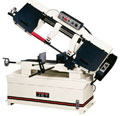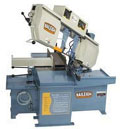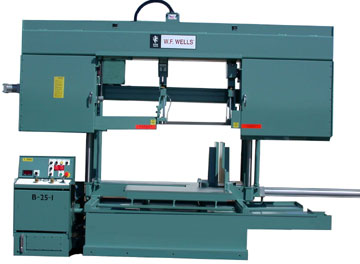|
Band
Saw Blades
|
|||||
 |
|||||
HOW TO CHOOSE A METAL CUTTING BAND SAW BLADE - RAKE, MATERIAL AND TEETH:
Bandsaw blades used for cutting metal have bent teeth. The bend in the teeth creates a cut slightly wider than the thickness of the blade, which is important to prevent the blade from getting stuck from being pinched by the metal. There are 3 different blade tooth patterns: raker, wave, and straight. For most metal cutting work, use the raker pattern. But if you are cutting thin work sections, such as tubing, angles, and channels, then consider using a blade with the wave tooth pattern. At least three teeth of the bandsaw blade must contact the workpiece at all times to prevent chatter and shearing off teeth due to tooth overload. Therefore, use fine tooth blades for cutting sheet metal and tubing. If the sheet metal is too thin for this to work with the finest tooth blade available, a useful trick is to put the metal between pieces of plywood, fiberboard, or soft thicker metal to support the blade. Our webpage How to use a BandSaw has a guide for selecting the proper pitch band saw blade for different metals and metal thickness.
The resulting finish mostly depends upon the saw pitch. The faster the blade speed and the finer the blade, the finer the finish will be. Cutting fluid also helps to improve the finish. A fine saw pitch blade, at high speed, with a light feed will produce the finest finish.
Bandsaw blades normally get dull from use, but some precautions will give you longer than normal wear on the blades. Blades will dull quickly if used at too rapid a speed for the metal being cut. Also, if the metal to be cut is too hard for the pitch of the blade, you will experience abnormal wear. The most common cause of premature blade wear comes from using too fine a pitch blade and from feeding the blade too heavy.
Symptoms
indicate a dull bandsaw blade that should be replaced:
* It becomes difficult to follow a line, the blade being forced to one
side or the other.
* The chips are granular (except for cast iron, which produces granular
chips with both sharp and dull blades).
* The bandsaw blade cuts slowly or not at all when the workpiece is fed
by hand.
* With the bandsaw off and/or the blade removed, run a finger slowly over
the teeth in the direction of cut. If you do not feel sharp edges then
the blade is dull.
To help choose a band saw blade, here is a chart showing the recommended number of teeth for various materials and thicknesses:
| Recommended use of a CARBON STEEL BLADE | Thickness of metal to be cut | Blade Teeth per inch |
| For high speed cutting of aluminum, brass, copper, soft bronze, magnesium, wood, mild steel and also tougher steels at slow speed. | 1/2" to 3-3/8 inch thick | 6 |
| For high speed cutting of aluminum, brass, copper, soft bronze, magnesium, wood, mild steel and also tougher steels at slow speed. |
3/8"
to 1 inch thick
|
8
|
| For high speed cutting of aluminum, angle iron, cast iron, bronze, brass, copper, galvanized pipe, mild steel, and also tougher steels at slow speed. |
3/16"
to 3/4 inch thick
|
10
|
| For high speed cutting of aluminum, angle iron, cast iron, bronze, brass, copper, galvanized pipe, mild steel, and also tougher steels and electric cable at slow speed. |
5/32"
to 1/2 inch thick
|
14
|
| For high speed cutting of angle iron, cast iron, bronze, brass, copper, galvanized pipe, thin wall tubing, mild steel, and also tougher steels at slow speed. |
1/8"
to 1/4 inch thick
3/32" to 1/8 inch thick |
18
|
| Recommended use of a ALLOY STEEL BLADE |
Thickness
of metal to be cut
|
Blade
Teeth per inch
|
| For high speed cutting of aluminum, cast iron, bronze, brass, copper, galvanized pipe, mild steel, and also tougher steels including chrome and tungsten steels at slow speed. |
3/16"
to 1 inch thick
|
10
|
| For high speed cutting of angle iron, cast iron, bronze, brass, copper, galvanized pipe, thin wall tubing, mild steel, and also tougher steels including chrome and tungsten steels and electric cable at slow speed. |
5/32"
to 3/4 inch thick
|
14
|
| For high speed cutting of angle iron, bronze, brass, copper, galvanized pipe, thin wall tubing, mild steel, and also tougher steels including chrome and tungsten steels at slow speed. |
1/8"
to 1/2 inch thick
|
18
|
| For high speed cutting of angle iron, bronze, brass, copper, galvanized pipe, thin wall tubing, mild steel, and also tougher steels at slow speed. |
3/32"
to 1/8 inch thick
|
24
|
| Recommended use of a HIGH SPEED STEEL BLADE |
Thickness
of metal to be cut
|
Blade
Teeth per inch
|
| For high speed cutting of aluminum, angle iron, bronze, brass, copper, galvanized pipe, mild steel, and also tougher steels including stainless, chrome, tungsten steels and other problem materials at slow speed. |
7/32"
to 7/8 inch thick
3/16" to 5/8 inch thick 5/32" to 3/8 inch thick |
10
14 18 |
In general
the following rule applies to choosing the speed of your bandsaw blade:
The harder the material, the slower the speed; conversely, the softer
the material, the faster the speed.
The faster the speed, the finer the finish produced on the cut surface.
Remember to put proper tension on your blade before using the bandsaw and release the tension when you are done.
|
|
Click to return to our Machine Tool Blog
Click for the American Machine Tool Homepage
5864 Northwest Hwy
Chicago IL 60631 USA
Phone: 773-334-5000
Fax: 773-442-0314
Click to email us
Copyright © 2013
American Machine Tools Corp.
All rights reserved
Offers from American Machine Tools Corporation include include Terms and Conditions shown on our website.
Liability is strictly limited to those warranties of fitness for purpose and safety as provided by the manufacturer.
Products and Logos in this website are trademarks or registered trademarks of their respective companies or mark holders.



